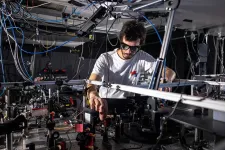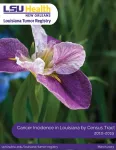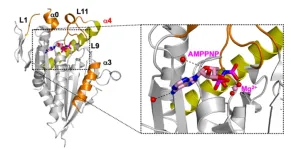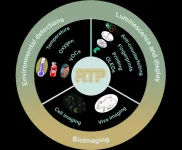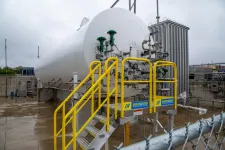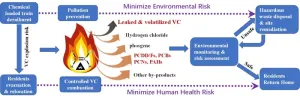(Press-News.org) Imperial physicists have recreated the famous double-slit experiment, which showed light behaving as particles and a wave, in time rather than space.
The experiment relies on materials that can change their optical properties in fractions of a second, which could be used in new technologies or to explore fundamental questions in physics.
The original double-slit experiment, performed in 1801 by Thomas Young at the Royal Institution, showed that light acts as a wave. Further experiments, however, showed that light actually behaves as both a wave and as particles – revealing its quantum nature.
These experiments had a profound impact on quantum physics, revealing the dual particle and wave nature of not just light, but other ‘particles’ including electrons, neutrons, and whole atoms.
Now, a team led by Imperial College London physicists has performed the experiment using ‘slits’ in time rather than space. They achieved this by firing light through a material that changes its properties in femtoseconds (quadrillionths of a second), only allowing light to pass through at specific times in quick succession.
Lead researcher Professor Riccardo Sapienza, from the Department of Physics at Imperial, said: “Our experiment reveals more about the fundamental nature of light while serving as a stepping-stone to creating the ultimate materials that can minutely control light in both space and time.”
Details of the experiment are published today in Nature Physics.
The original double-slit setup involved directing light at an opaque screen with two thin parallel slits in it. Behind the screen was a detector for the light that passed through.
To travel through the slits as a wave, light splits into two waves that go through each slit. When these waves cross over again on the other side, they ‘interfere’ with each other. Where peaks of the wave meet, they enhance each other, but where a peak and a trough meet, they cancel each other out. This creates a striped pattern on the detector of regions of more light and less light.
Light can also be parcelled up into ‘particles’ called photons, which can be recorded hitting the detector one at a time, gradually building up the striped interference pattern. Even when researchers fired just one photon at a time, the interference pattern still emerged, as if the photon split in two and travelled through both slits.
In the classic version of the experiment, light emerging from the physical slits changes its direction, so the interference pattern is written in the angular profile of the light. Instead, the time slits in the new experiment change the frequency of the light, which alters its colour. This created colours of light that interfere with each other, enhancing and cancelling out certain colours to produce an interference-type pattern.
The material the team used was a thin film of indium-tin-oxide, which forms most mobile phone screens. The material had its reflectance changed by lasers on ultrafast timescales, creating the ‘slits’ for light. The material responded much quicker than the team expected to the laser control, varying its reflectivity in a few femtoseconds.
The material is a metamaterial – one that is engineered to have properties not found in nature. Such fine control of light is one of the promises of metamaterials, and when coupled with spatial control, could create new technologies and even analogues for studying fundamental physics phenomena like black holes.
Co-author Professor Sir John Pendry said: "The double time slits experiment opens the door to a whole new spectroscopy capable of resolving the temporal structure of a light pulse on the scale of one period of the radiation."
The team next want to explore the phenomenon in a ‘time crystal’, which is analogous to an atomic crystal, but where the optical properties vary in time.
Co-author Professor Stefan Maier said: “The concept of time crystals has the potential to lead to ultrafast, parallelized optical switches.”
END
Double-slit experiment that proved the wave nature of light explored in time
2023-04-03
ELSE PRESS RELEASES FROM THIS DATE:
Researchers show lorlatinib is safe and effective for patients with ALK-driven relapsed/refractory high-risk neuroblastoma
2023-04-03
Philadelphia, April 3, 2023—In a significant step for the treatment of neuroblastoma, an international group of researchers led by Children’s Hospital of Philadelphia (CHOP), Winship Cancer Institute of Emory University and the New Approaches to Neuroblastoma Therapy (NANT) Consortium has shown that the targeted therapy lorlatinib is safe and effective in treating high-risk neuroblastoma. The findings, published today in Nature Medicine, have led to a major amendment in a phase 3 Children’s Oncology Group (COG) clinical trial, which has incorporated lorlatinib for newly diagnosed ALK-driven high-risk neuroblastoma, ...
Hidden ice melt in Himalaya: Study
2023-04-03
A new study reveals that the mass loss of lake-terminating glaciers in the greater Himalaya has been significantly underestimated, due to the inability of satellites to see glacier changes occurring underwater, with critical implications for the region's future projections of glacier disappearance and water resources.
Published in Nature Geoscience on April 3, the study was conducted by an international team including researchers from the Chinese Academy of Sciences (CAS), Graz University of Technology (Austria), the University of St. Andrews (UK), and Carnegie Mellon ...
Hannover Messe: Smart films help to make loudspeakers lighter and more energy-efficient
2023-04-03
Professors Stefan Seelecke and Paul Motzki at Saarland University are developing intelligent materials that are opening up new avenues in sound reproduction technology: lightweight loudspeakers that use far less energy than their conventional counterparts, novel shapes for sound and signal generators and applications involving noise cancelling textiles. The basis for these smart materials are ultrathin silicone films that can act as artificial muscles with their own built-in sensors. The research team will be showcasing their new technology at this year’s Hannover Messe from 17 to 21 April (Hall 2, Stand B34).
Ultrathin films may well replace the heavy and power-thirsty ...
LSU Health New Orleans LA Tumor Registry releases 6th Census Tract Cancer Incidence Report
2023-04-03
New Orleans, LA -- LSU Health New Orleans Louisiana Tumor Registry (LTR) has published the sixth report of statewide cancer incidence rates by census tract. The publication, which reports 2010-2019 combined cancer incidence data, found that 81% of the census tracts in Louisiana met publication criteria for all cancers combined. For specific cancer types, fewer census tracts met the criteria. For the Louisiana census tracts meeting the criteria, the incidence rates for all cancers combined and for specific cancer types were compared with the corresponding rates for the entire state. The ...
Anticancer drugs with fewer side-effects: scientists decode the crystal structure of a key cell cycle protein
2023-04-03
Anticancer drugs are pivotal to cancer treatment, but their toxicity may not always be limited to cancer cells, resulting in harmful side-effects. To develop anticancer therapies that have fewer adverse effects on patients, scientists are now focusing on molecules that are less toxic to cells. One such group of drugs is the "kinesin inhibitors." These inhibitors prevent cancer progression by explicitly targeting kinesin motor proteins, which are required for the division of cancer cells. Centromere-associated protein E (CENP-E), a member of the kinesin motor protein, is a promising target for inhibitor therapy, as it is essential for tumor cell replication. However, determining the ...
Researchers reviewed recent progress of organic room-temperature phosphorescent materials towards application
2023-04-03
Organic materials with room-temperature phosphorescence (RTP) emission have attracted extensive attention due to extraordinary properties including long lifetime, large Stokes shift, stimuli-responsiveness, and so on, and show bright prospects in broad fields. However, the energy of the excited state of organic phosphors is easily consumed through thermal radiation and collision deactivation. Therefore, numerous design strategies such as creating a rigid environment through crystallization and supramolecular assembly are employed to improve the luminescent characteristics of RTP materials by restricting nonradiative transition, enhancing intersystem crossing, and so forth. A team ...
American Kidney Fund awards fellowships to researchers focused on barriers to home dialysis and living donor transplants among youth; COVID-19 vaccine booster disparities in the dialysis community
2023-04-03
ROCKVILLE, Md. (April 3, 2023)— Today the American Kidney Fund (AKF) announced the recipients of this year’s Clinical Scientist in Nephrology (CSN) fellowship program, in which promising researchers work to improve the quality of care for people living with kidney disease and promote clinical research in nephrology. Dr. Alexandra Bicki, a pediatric nephrology fellow at the University of California, San Francisco, will be working on identifying facilitators and barriers to home dialysis and living kidney donor transplantation among adolescents and young adults, while Dr. Nivetha Subramanian, a nephrology fellow at ...
SwRI expands hydrogen energy research capabilities with new liquid hydrogen storage tank
2023-04-03
SAN ANTONIO – April 3, 2023 — Southwest Research Institute has installed a large-capacity liquid hydrogen tank to expand its advanced hydrogen energy research initiatives. Leveraging the tank’s capabilities alongside a multidisciplinary research approach, SwRI endeavors to explore technology opportunities and address obstacles related to hydrogen energy research and development.
The SwRI liquid hydrogen storage tank has a capacity of 17,000 gallons and will provide the Institute with a cost-effective, reliable supply of hydrogen ...
International research team analyzes February 2023 Ohio train derailment
2023-04-03
On February 3, 2023, a train derailed in the United States near East Palestine, Ohio, leading to the combustion of vinyl chloride. Following that accident, an international team of researchers undertook an in-depth analysis of the environmental consequences of the accident.
Their analysis is published in the journal Frontiers of Environmental Science & Engineering on March 15, 2023.
In their analysis, the team examined a series of questions related to the environmental risk and management of the chemical accident. “We emphasized that it is unscientific to overestimate or underestimate the environmental ...
Using artificial intelligence to design innovative materials
2023-04-03
Advanced materials are urgently needed for everyday life, be it in high technology, mobility, infrastructure, green energy or medicine. However, traditional ways of discovering and exploring new materials encounter limits due to the complexity of chemical compositions, structures and targeted properties. Moreover, new materials should not only enable novel applications, but also include sustainable ways of producing, using and recycling them. Researchers from the Max-Planck-Institut für Eisenforschung (MPIE) review the status of physics-based modelling ...
